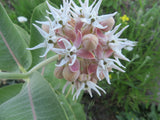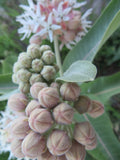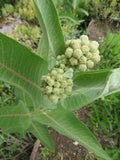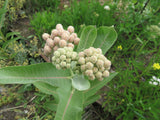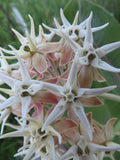Quick facts
- Host plant of the monarch butterfly
- Beautiful flowers
- Attracts a wide diversity of pollinators
- Drought or dry-garden tolerant
Asclepias speciosa
Western native wildflower famous for being the host plant of the monarch butterfly. Host plant simply means that monarch mamas lay their eggs on or near milkweed plants so that hatching caterpillars can feed on the milkweed leaves. Showy milkweed leaves are slightly toxic and impart this toxicity to the feasting caterpillars- giving them their primary defense mechanism!
Additionally, milkweed flowers are stunningly beautiful and attract a wide variety of pollinators- not just monarchs. Being a native wildflower it is drought tolerant and appropriate for dry gardens. Contrary to what its name suggests, we have not found milkweed to be a exceptionally weedy plant and it does not spread or reseed with abandon. We'll get a few plants we didn't intentionally plant every year, but nothing that has us concerned.
Monarch populations have been on steep decline in recent decades. To learn more about the causes of this, visit the Xerces Society for Invertebrate Conservation's page on the monarch decline. The reasons for this decline include habitat loss in their overwinter habitat in Mexico and pesticides. One primary reason for their decline is the decline of their host plant- milkweed- all over the west and midwestern United States. Reasons for this include the use of GMO Round-up Ready crops which allow the spraying of herbicides over vast amounts of acres, killing milkweed where it grows in fields, along, roadsides and in ditches.
This is one problem where you can make a difference! You can help save the monarch butterfly by planting milkweed in your own garden!
How to grow it:
|
Germ Temp |
Indoor Start |
Germ Days |
Frost Tolerant |
Sun |
Seed Depth |
Plant/Row Spacing |
|
65-85 |
4-6 w. |
6-21 d. |
Yes |
Full |
1/4” |
3-6”/8-10” |
As a native wildflower, milkweed germination will be greatly enhanced if you give them a "winter" before you expect them to grow. This can be done either by planting them in the fall, or by cold stratifying them in a moist paper towel in a plastic bag in the refrigerator for 1-2 months. Planting them in the fall in a weed free location is the simplest, but we have found the most success when we cold stratify them and start them in pots in a greenhouse or under a grow light. If planting inside, do this 4-6 weeks before you expect to transplant them. Sow 1/4" deep, and thin to about 8" between plants. Because they tolerate dry conditions, we plant these in our native plants dry garden. We love to plant them where we will see them often, so we can see if we find any monarch caterpillars munching on them- or better yet catch a monarch mama in the process of laying her eggs on them!
Seed specs: Packet size ~100 seeds






